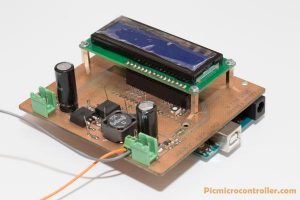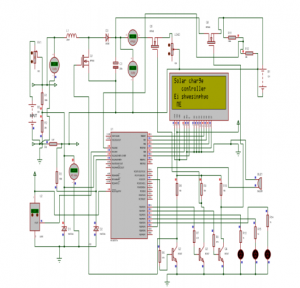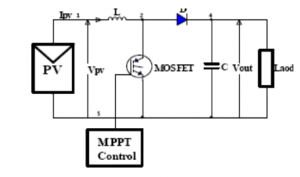Summary of MPPT Based Charge Controller Using Pic Microcontroller
This article discusses an MPPT-based charge controller using a PIC16F877A microcontroller for photovoltaic (PV) systems. It explains the importance of MPPT techniques to optimize power output despite varying insolation and temperature. The PIC microcontroller manages charging and protects the battery by controlling disconnect/reconnect actions, displaying temperature, voltage, and current via an LCD, and signaling status through LEDs. The system includes a boost converter and uses mikroC software for intelligent control, utilizing multiple I/O ports for sensor inputs, LCD interface, PWM generation, and status indicators.
Parts used in the MPPT Based Charge Controller Using Pic Microcontroller:
- PIC16F877A Microcontroller
- LCD Module
- Temperature Sensing Circuit
- Battery Voltage Sensing Circuit
- Current Sensing Circuit
- Boost Converter Circuit
- LED Indicators
- Buzzer
- Switches for control inputs
In this post we will briefly discuss about MPPT Based Charge Controller Using Pic Microcontroller. Photovoltaic is one of the renewable energy resources that recently has become broader in nowadays technology. The electricity generations of photovoltaic (PV) panels are strongly related with insolation and temperature.

The insolation and temperature are not stable, since the electricity generations of the PV panels are not stable. In PV systems, insolation and temperature continuous vary. Therefore, the maximum power point tracking (MPPT) techniques are used to give the highest power to the loads/batteries. The MPPT process is performed with a power electronic circuit and it overcomes the problem of voltage mismatch between the PV panels and the batteries/loads. In this system, a microcontroller is employed to develop battery charge control system for PV panels.
This system deals with the design of an intelligent charge controller
using PIC microcontroller to control and coordinate the activity in charge controller. The proposed charge controller is equipped with LCD to display the temperature, battery voltage and current flow through the battery. Output of these 3 inputs are used to obtain the accurate and efficient disconnecting/reconnecting action which is capable of protecting the battery and the load whereas LED indicator is featured to show the status of the systems.
Introduction:
Photovoltaic sources are used today in many applications. They have the advantage of being maintenance and pollution-free but their installation
cost is high and, in most applications; they require a power conditioner (dc/dc or dc/ac converter) for load interface. Since PV modules still have relatively low conversion efficiency, the overall system cost can be reduced using high efficiency power conditioners which, in addition, are designed to extract the maximum possible power from the PV module [maximum power point tracking (MPPT).
Stucture of MPPT Based Charge Controller Using Pic Microcontroller:

Software is crucial element in the development of solar charge controller. The main objective of the software development is to give instruction, control and coordinate the PIC16F877A to execute various tasks. In this case, mikroC code is written for the software development of solar charge controller. Microcontroller based designs are able to provide more intelligent control with the same device simply by changing the program parameters and/ or adding more sensors and by matching it to the various
stages of charge of the battery.
Boost Converter Diagram:

Microcontroller based charge controller design is feasible for performing complex task. PlC16F877A microcontroller used in this charge controller is the central of coordinating all system’s activity. It is designed in 40 pin DIP package (Dual In Line Package) and it is the member from microcontroller 8-bit “Reduced Instruction Set Computer Central Processing Unit family” (RISC CPU) which implement the Harvard architecture by separating code and data spaces. Here, PlC16F877A microcontroller is used to control the operation of charging control and data acquisition task in this project. PlC16F877A contains 5 I/O ports which are suitable for the development of the charge controller. Port A is used to perform the analog to digital conversion which is used in input parts like temperature sensing circuit, battery voltage sensing circuit and current sensing circuit. Port B is used to interface with the LCD module whereas port C controls disconnect or reconnect operations for photovoltaic panel or load and also triggering
the buzzer and generating the PWM signal to control the boost converter. Port D is used as input part for switching control and as output part for LED indicator.
For another similar project visit here:
Source: MPPT Based Charge Controller Using Pic Microcontroller
